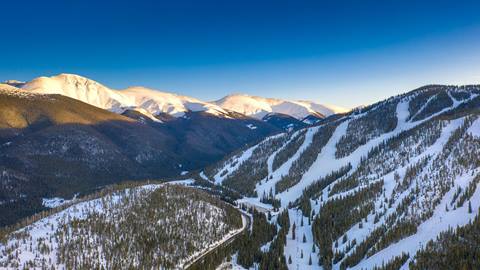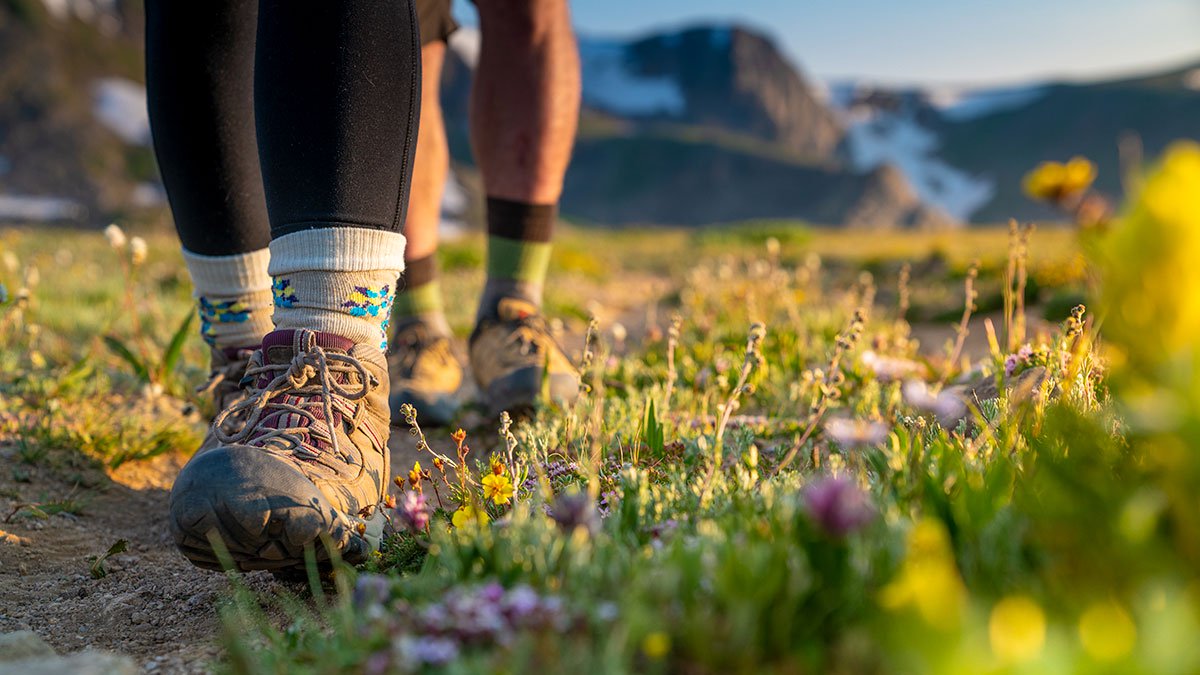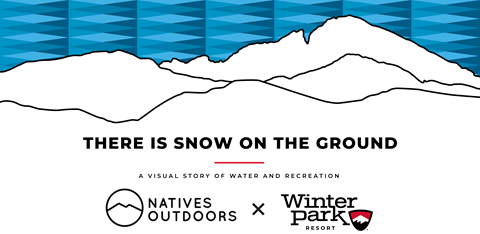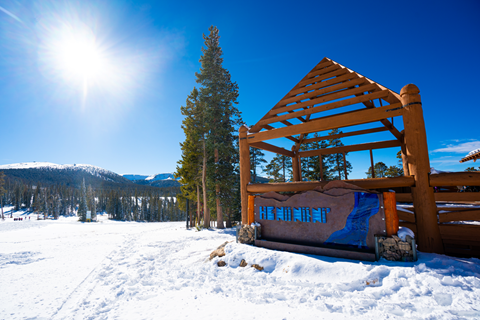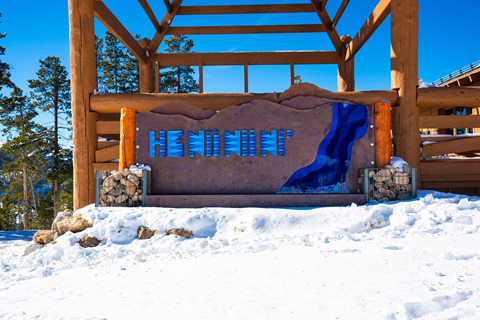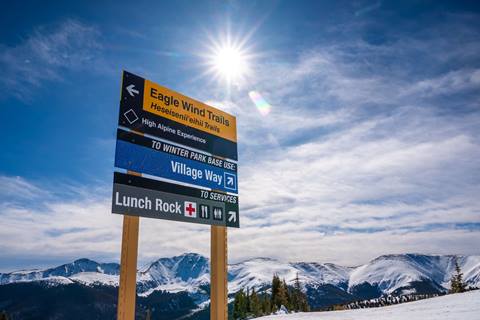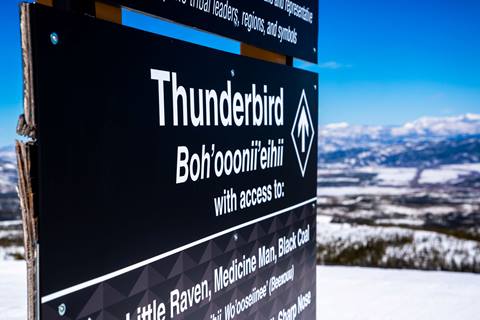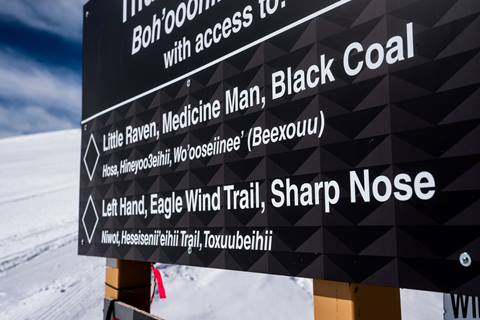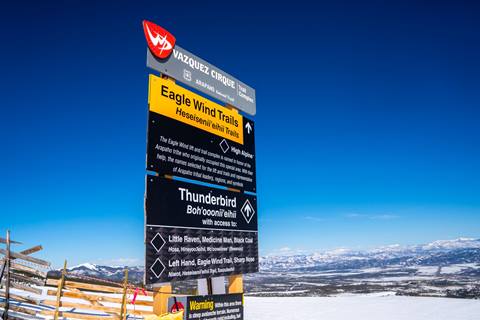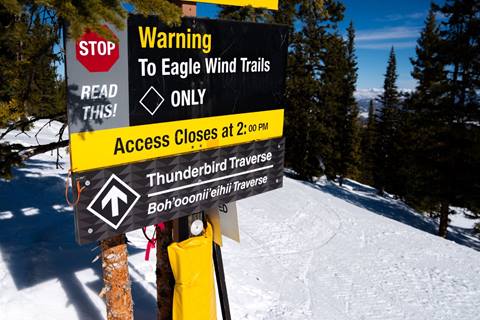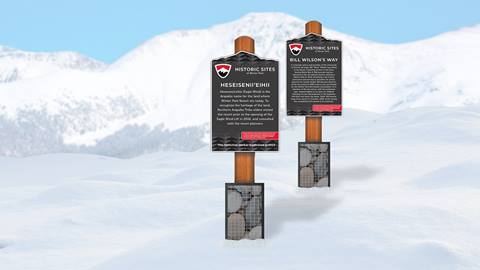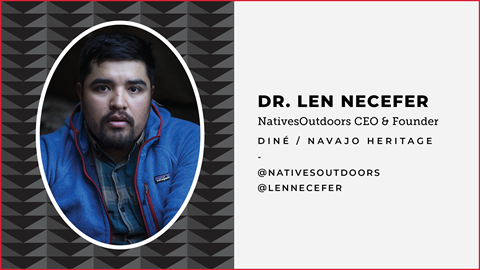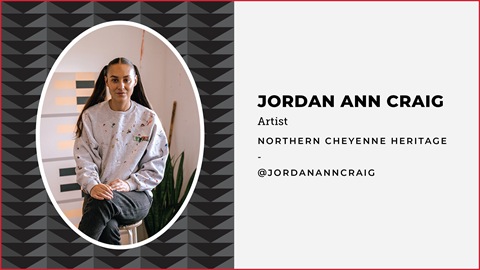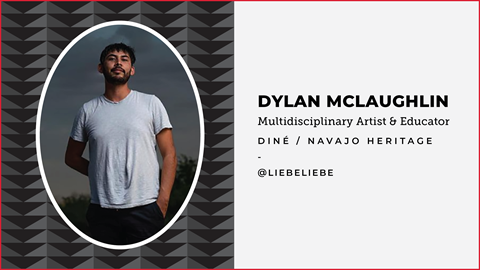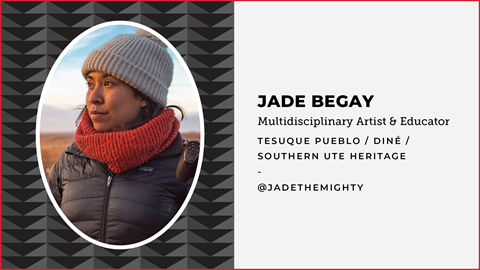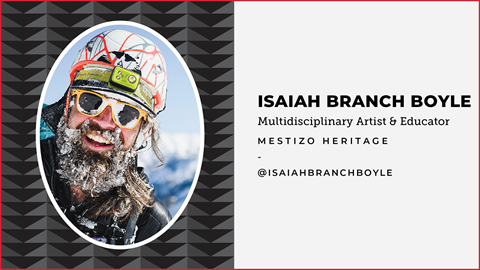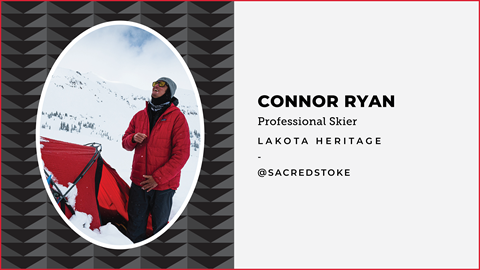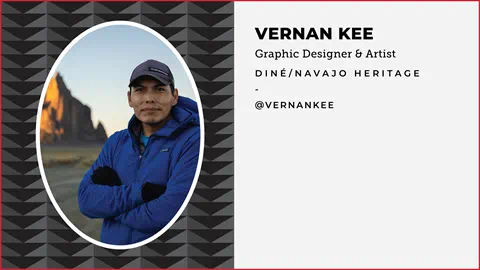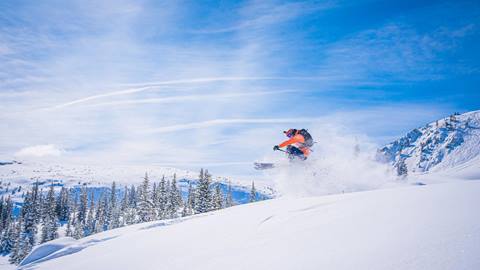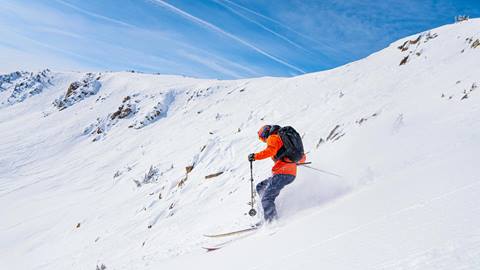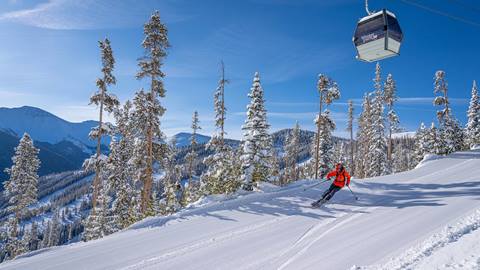There Is Snow On The Ground
Located at the headwaters of the Colorado River, Winter Park Resort is more than a powder day destination: it’s a vital source of snowmelt that nourishes ecosystems. Four years ago, we began a partnership with Indigenous artists and NativesOutdoors to elevate this story and explore the connections between people, place, and snow.
The resulting art installation is called There Is Snow On The Ground which is the Arapaho translation of the word heniiniini'. This multifaceted installation invites guests to reconsider their relationship to the mountain and recreation by acting as a catalyst for deeper (and often complicated) conversations about snow, land, ecosystems, and climate change.
rich-text, responsive-table
The resulting art installation is called There Is Snow On The Ground which is the Arapaho translation of the word heniiniini'. This multifaceted installation invites guests to reconsider their relationship to the mountain and recreation by acting as a catalyst for deeper (and often complicated) conversations about snow, land, ecosystems, and climate change.
Jump ahead to learn more about: Art Installation | Snow Stake | Trail Signs | Historical Markers | Artist Statements
rich-text, responsive-table
Heniiniini’. There Is Snow On The Ground.
In many watersheds in the Western United States, more water is stored in the mountain snowpack than in the region’s human-built reservoirs. As the climate has warmed, spring snowpack across the American West has declined by nearly 20 percent on average between 1955 and 2020 — and by significantly more at some individual locations, according to an analysis by the U.S. Environmental Protection Agency.
The heniiniini’ art installation brings this story to life by showcasing four mountain outlines — Longs Peak, Mount Blue Sky, Byers Peak, and Parry Peak —which symbolize the four directions that ground us to this place. Winding its way down from the peaks, a river flows into the garden bed below and nourishes an array of native plant species during the summer. This functional purpose serves to remind us of the life-sustaining water kept in the snowpack we recreate on each winter. The word "heniiniini’" is boldly displayed, with a pattern created for this project by Jordan Craig and Vernan Kee.
rich-text, responsive-table
The heniiniini’ art installation brings this story to life by showcasing four mountain outlines — Longs Peak, Mount Blue Sky, Byers Peak, and Parry Peak —which symbolize the four directions that ground us to this place. Winding its way down from the peaks, a river flows into the garden bed below and nourishes an array of native plant species during the summer. This functional purpose serves to remind us of the life-sustaining water kept in the snowpack we recreate on each winter. The word "heniiniini’" is boldly displayed, with a pattern created for this project by Jordan Craig and Vernan Kee.
rich-text, responsive-table
Snow Stake
What does snow mean to you? During the winter, the snow stake at Winter Park is a daily point of conversation for skiers and riders who use the tool to get the most out of their day on the mountain. We have incorporated it into this project as a reminder for all of us that although we look forward to powder days, the gift of precipitation holds a deeper meaning. With this project, the snow stake serves as an invitation for us all to engage in meaningful conversations about snow and to consider our relationship to the mountain, recreation, and the environment.
The backdrop of the snow stake incorporates the same four outlines of Longs Peak, Mount Blue Sky, Byers Peak, and Parry Peak — grounding us in the four directions that anchor Winter Park. A river reminds us of the snow's journey: from powder day to runoff in the Colorado River which then sustains all living things downstream. The ruler and backdrop feature patterns created by artists Jordan Craig and Vernan Kee. rich-text, responsive-table
The backdrop of the snow stake incorporates the same four outlines of Longs Peak, Mount Blue Sky, Byers Peak, and Parry Peak — grounding us in the four directions that anchor Winter Park. A river reminds us of the snow's journey: from powder day to runoff in the Colorado River which then sustains all living things downstream. The ruler and backdrop feature patterns created by artists Jordan Craig and Vernan Kee. rich-text, responsive-table
Trail Signs
People have lived in, cared for, and built relationships with the mountains and snowpack in the Fraser Valley long before the ski resort existed. The land's original stewards — the Cheyenne, Ute, and Arapaho people — all have ancestral ties to this area, and the Arapaho people have named it ‘Eagle Wind.’
To recognize the heritage of the land, Northern Arapaho Tribe elders visited the resort prior to the opening of the Eagle Wind Lift in 2006 and consulted with resort planners. Each Eagle Wind terrain trail name emerged from those consultations as a way to pay tribute to the area.
As part of Winter Park’s continued commitment to honor the full story of the land, and as part of the There Is Snow On The Ground installation, the trail signs will be updated with a pattern designed by Jordan Craig. The trail names will also now feature a translation in the Arapaho Language.
rich-text, responsive-table
To recognize the heritage of the land, Northern Arapaho Tribe elders visited the resort prior to the opening of the Eagle Wind Lift in 2006 and consulted with resort planners. Each Eagle Wind terrain trail name emerged from those consultations as a way to pay tribute to the area.
As part of Winter Park’s continued commitment to honor the full story of the land, and as part of the There Is Snow On The Ground installation, the trail signs will be updated with a pattern designed by Jordan Craig. The trail names will also now feature a translation in the Arapaho Language.
rich-text, responsive-table
Historical Markers
Winter Park's historical markers highlight influential figures who shaped the course of the resort's history since 1940. However, in 2021, we saw an opportunity to renew our commitment to telling a more authentic, complete story of the region that existed beyond our founding date. So, we partnered with Native Indigenous peoples to issue a land acknowledgment statement that recognized the heritage of the land's original stewards.
Today, There Is Snow On The Ground has given us another opportunity to continue this betterment in storytelling. Our existing historical markers will be updated with the pattern created by Jordan Craig, mountain outlines from the four directions, and our land acknowledgement statement. We will also add additional markers noting Eagle Wind and other Arapaho placenames.
rich-text, responsive-table
Today, There Is Snow On The Ground has given us another opportunity to continue this betterment in storytelling. Our existing historical markers will be updated with the pattern created by Jordan Craig, mountain outlines from the four directions, and our land acknowledgement statement. We will also add additional markers noting Eagle Wind and other Arapaho placenames.
rich-text, responsive-table
Artists' Statement
Heniiniini’. There Is Snow On The Ground. A place's name channels the spirit of the land and evokes powerful emotions. Yet, for the Indigenous peoples who call this region home, shifting terminology is a grim reality. Dispossession, removal, and a changing climate are threatening the names of landscapes on which identities have been built.
So, as the next generations to love the land, how can we preserve these cultures and learn from its original stewards?
This begins by listening to the story of the snow. With each fresh fall, it brings a gift of life — blanketing forests, feeding into rushing rivers, and carrying vitality down into the valley. More than providing powder days and perfect turns, the snow sustains our ecosystem, and we must answer the call to give back. By elevating Indigenous perspectives, we can come together as one to nurture a reciprocal relationship with the mountain and ensure its story continues to thrive.
NativesOutdoors: A Native-Owned Athletic and Creative Collective working to empower Indigenous communities through storytelling for a sustainable world.
rich-text, responsive-table
So, as the next generations to love the land, how can we preserve these cultures and learn from its original stewards?
This begins by listening to the story of the snow. With each fresh fall, it brings a gift of life — blanketing forests, feeding into rushing rivers, and carrying vitality down into the valley. More than providing powder days and perfect turns, the snow sustains our ecosystem, and we must answer the call to give back. By elevating Indigenous perspectives, we can come together as one to nurture a reciprocal relationship with the mountain and ensure its story continues to thrive.
NativesOutdoors: A Native-Owned Athletic and Creative Collective working to empower Indigenous communities through storytelling for a sustainable world.
rich-text, responsive-table
Winter Park Resort has forged an ongoing partnership with NativesOutdoors as part of our People, Planet, Community initiative. They were an integral part of our land acknowledgment, have played a critical role in our content strategies, and have been a bridge as we seek to build deeper relationships with indigenous communities. Their insight on reciprocity and land stewardship is invaluable, and we rely on them as partners in our goal to implement Indigenous perspectives and values into our work.
Their advocacy and storytelling in the land, water, and environmental space is inspiring. With the support of NativesOutdoors, this project weaves a narrative that is both visually compelling while touching on diversity, equity, inclusivity, and belonging.
@NativesOutdoors | @Lennecefer | @Liebeliebe |@Sacredstoke |@Isaiahbranchboyle |@Jadethemighty |@Jordananncraig |@Vernankee
rich-text, responsive-table
Their advocacy and storytelling in the land, water, and environmental space is inspiring. With the support of NativesOutdoors, this project weaves a narrative that is both visually compelling while touching on diversity, equity, inclusivity, and belonging.
@NativesOutdoors | @Lennecefer | @Liebeliebe |@Sacredstoke |@Isaiahbranchboyle |@Jadethemighty |@Jordananncraig |@Vernankee
rich-text, responsive-table
